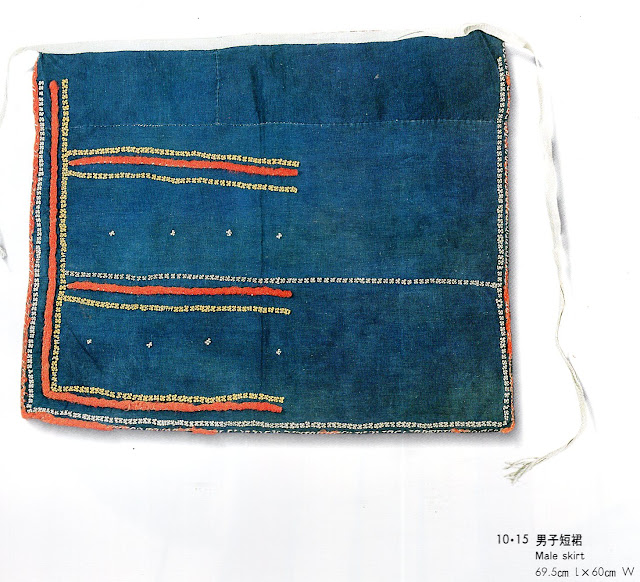Hello all,
Today I will continue my description of the Costumes of the Taiwanese aboriginal peoples. I will cover the central tribes: Amis, Kavalan, Sakizaya, Thao and Tsou.
Amis
https://en.wikipedia.org/wiki/Amis_people
https://www.dmtip.gov.tw/web/en/page/detail?nid=4
This is the largest indigenous group, numbering some 200,000 people. Their self designation is Pangcah, 阿美族 in Chinese. Amis is the most common term used today. It means 'people of the north', and may originally have been applied to them by the Puyuma, who live to their south. They inhabit the Huatang valley and the coastal plain on the east central part of Taiwan.
The Amis use many of the same garments as are found in the northern tribes, with some additions. One in particular is popular among the southern tribes. Chinese books call them male leg coverings.
At first glance, these seem to be pants, but in fact they are chaps. They cover only the front of the legs, and are tied at the waist, knee, and ankle.
Short jackets with sleeves are worn, and unlike in the northern tribes, these have an overlapping panel in front.
Women's jackets are designed differently.
The men may wear these over short wrap skirts.

Women wear wrap skirts and tied on leggings, as in the northern tribes. They may also wear a contrasting front panel, resembling an apron.
Both men and women wear much jewelry, and elaborate headdresses, the men's with tall feathers on festive occasions.
Kavalan
https://en.wikipedia.org/wiki/Kavalan_people
https://www.dmtip.gov.tw/web/en/page/detail?nid=7
This term means 'people of the plains', they are called 噶瑪蘭族 in Chinese . They currently number around 1500. They originally inhabited the plains in the northeast of the island. In 1878, in response to encroachment by Han Chinese settlers, they, together with the Sakizaya, fought against the settlers. The result was disaster for all involved. More Han settlers arrived, and the remnants of both the Kavalan and the Sakizaya fled south and took refuge among the Amis. The Kavalan were only recognized as a distinctive group in 2002. The Kavalan live on the east coast in the northern part of Amis territory, surrounded by Amis on three sides.
Sakizaya
https://en.wikipedia.org/wiki/Sakizaya_people
撒奇萊雅族 in Chinese. These people number about 1000, they live on the east coast north of the Amis and Kavalan. After a revolt during the Qing dynasty and under Japanese occupation they hid among the Amis, and were only recognized as a separate people in 2007. They live on the east coast north of the Kavalan. Sakizaya costume is distinguished by a strong use of yellow. The garments themselves resemble those of their neighbors.
Thao
https://en.wikipedia.org/wiki/Thao_people
https://www.dmtip.gov.tw/web/en/page/detail?nid=13
The Thao are a small people, numbering around 800. They are also called Ngan, or 邵族, Shào zú in Chinese. They live near Sun Moon Lake, south of the Seediq and northwest of the Bunun. They have retained a distinct language and culture in spite of the small size of their population. Today they are mostly involved with the tourism industry, as the lake is a popular attraction.
Tsou
https://en.wikipedia.org/wiki/Tsou_people
https://www.dmtip.gov.tw/web/en/page/detail?nid=15
The Tsou, also spelled Cou, Zou or 鄒 number perhaps 6000. they live south of the Thao and west of the Bunun. The northern branch calls itself the Alishan. The two southern groups call themselves the Kanakanavu and the Hla'alua. Each of these has recently been recognized by the government as a separate people. I have not been able to separate the costume by group, however. The costume seems to closely resemble that of the Thao.
This concludes my second article on the Taiwanese Aboriginals.
Thank you for reading, I hope that you have found this to be interesting and informative.
Roman K
email: rkozakand@aol.com









































































































































































